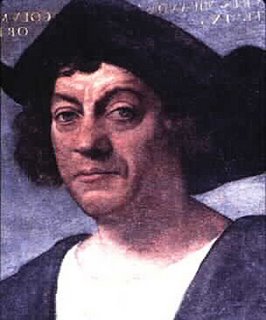Cristoforo Colombo

Denounced by some as a slaver and a thief, celebrated by others as the man who brought European civilization to the wilderness of the Western hemisphere, Christopher Columbus is at once a stock character on the stage of history about whom even schoolchildren can muster a few key facts, and yet something of a mystery when one attempts to view him in three dimensions. It is easiest and most faithful to render him as a man of action.
Born on this day in 1451 in Genoa, he was a sailor from the age of 14, settling in Lisbon in the 1470s after being wrecked off the coast of Portugal during a fight with some Venetian galleys; and over the years of voyages to Madeira and the Azores he became convinced that it was possible to reach Asia quickly by sailing west from Europe.
At the age of 33, he attempted to convince John II of Portugal to finance his unusual scheme in 1484, but John figured he had already spent good money and received good value in India by the Eastern route. Spain, on the other hand, had few possessions outside Europe other than the tiny Canary Islands off the coast of Africa. Thus it was with great economic interest that Isabella and Ferdinand of Spain eventually (after Columbus shopped the idea around England and France) invested in Columbus' gambit in 1492, hoping to find an easier trade route to India which might allow them to beat the Portuguese at their own game. With Isabella, however, it was more than just a financial matter; she hoped, and Columbus himself believed, that a Spanish route to India would result in the conversion of the Asian peoples to Christianity. The College of Salamanca advised against the investment, not on the basis that they disagreed with Columbus' assessment that the Earth was round, but because they believed the ocean stretching between the shores of Spain and the shores of China was unfathomably and impractically vast for navigation.
Nonetheless, with Spanish sponsorship, Columbus sailed from Palos on August 3, 1492 in 3 ships, the Nina, the Pinta and the Santa Maria, which were shabby and ill-equipped by Portuguese standards. After two months of sailing without land in sight, with Columbus' crews near mutiny, they spotted land on October 12. Columbus disembarked, with a letter to the grand khan in hand and an Arabic interpreter in tow, only to find the friendly, naked Arawak natives of what would come to be known as the Bahamas. Still in pursuit of China, Columbus set sail again and found Cuba (which he named Hispaniola) and started a small Spanish colony there with 40 members of his crew.
When he returned to Spain in March 1493, he maintained that he had found a new route to Asia, although skeptics cautiously settled on the notion that he had discovered some previously uncharted Indian islands ("Indies") far across the Atlantic. More importantly, Columbus brought back some gold with him, which intrigued Isabella and Ferdinand and spurred them to apply for and receive from Alexander VI the exclusive right to colonize the islands on which Columbus had landed, regardless of what they were.
Columbus was now hailed as a hero, and for his efforts he managed to extract a knighthood, the rank of Admiral of the Ocean and Viceroy of the Indies, and 10% of the wealth his voyages would reap. He returned with 17 vessels and 1,500 men in 1493, and was instructed to convert the natives to Christianity, expand the reach of Spanish power over the resources in the Indies and continue his search for the Asian ports. Upon reaching Hispaniola, he found certain indigenous factions were none too happy to see the Europeans, and Columbus inaugurated the practice of sending military expeditions inland to subdue the intransigent locals, slaughtering many of them, placing others into slavery (threatening to cut off the hands of those who did not collect their daily quota of gold for the Spanish treasury) and holding others hostage for more gold.
Upon his return in 1496, he found that the Spanish were not happy with his progress -- indeed, Isabella was horrified by his delivery of Indian slaves to her court -- and his exclusive license for exploration was terminated. During his third expedition up and down the uncharted South American coast (1498-1500), Columbus was arrested and placed in irons by the Spanish royal emissary, Francisco de Bobadilla, for "interference" -- although one suspects that he was really being punished for his poor administration of the colony at Hispaniola, which by that time was in disarray.
In hindsight it appears that the wild-eyed, arthritic old sailor had begun to lose his mind, struggling against the tide of cognitive dissonance between his lifetime goal and the magnitude of what he had actually accomplished by threatening to hang anyone who denied they were in India. Back in Spain, he managed to redeem himself in the eyes of the court (in part by appealing to their humanity; he insisted on wearing his chains until Isabella could see them), and was given one last fleet in 1502, which he used to explore the south shore of the Gulf of Mexico. He returned, ill, in 1504, and died in relative obscurity two years later in Valladolid, Spain.
Ultimately this blunt and grasping Genoan whose ill-formed vision drove him westward left little direct impact on the lands which he encountered, but he did test the endurance and capabilities of Spanish ships and their crews, brought new lands indelibly into the European consciousness and within the reach of European entrepreneurs, and set in motion the conquest and transformation of an entire continent.
Categories: Exploration





0 Comments:
Post a Comment
Subscribe to Post Comments [Atom]
<< Home